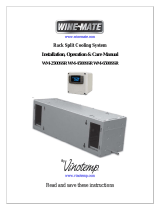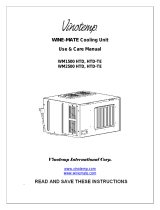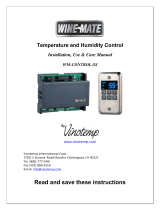Page is loading ...

WINE-MATE Cooling Unit
Service Manual
VINO-3500HZD
VINO-4500HZD
VINO-6500HZD
VINO-8500HZD
Vinotemp International Inc.
w
w
w
w
w
w
.
.
v
v
i
i
n
n
o
o
t
t
e
e
m
m
p
p
.
.
c
c
o
o
m
m
w
w
w
w
w
w
.
.
w
w
i
i
n
n
e
e
m
m
a
a
t
t
e
e
.
.
c
c
o
o
m
m

- 1 -
SAFETY INFORMATION

- 2 -
TABLE OF CONTENTS
1. Introduction………………………………………………..3
I. Goals and Objectives…………………….…...……………………………3
II. R134a Refrigerant Service Information.....................…………..…….3
2. Component Information and Access………………….5
I. Model and Serial Label Location…………………………………………5
II. Component Access…………………………………………………………6
1) Removing the Outer Cover…………………………..……………...…..6
2) Removing the Inner Styrofoam ..……………………………..6
3) Removing the Fan Plate….…………………..…………………………..8
4) Removing the Temperature Controller…..……..……………………..9
5) Removing the Thermistor…………………………………………….10
6) Removing Fan Motors…………………………………………………...10
7) Removing the Start Relay and Overload Protector …………….....10
8) Removing the Compressor……..………………………………………11
9) Removing the Condenser……..………………………………………..12
10) Removing the Evaporator…..…………………………………………..12
3. Servicing and Diagnosis……………………………….13
I. Identifying Component Problems.......……….…….………………….13
1) Terminal Block………………………………………………………….13
2) Compressor……………………………………………………………….14
3) Start Relay…………………………………………………………………15
4) Overload Protector.………………………………………………………16
5) Temperature Controller…………………………………………………16
6) Thermistor..………………………………………………………………..17
7) Fan Motors.………………………………………………………………..17
II. Wiring Diagram.….……..…………………………………..……………..18
III. Troubleshooting Chart.…....…………….………………………………19
4. Customer Support………………………………………24
5. Warranty Information…………………………………..25
I. Limited Warranty …………………………………..……………………..25
II. Limitation of Implied Warranty.………………………………………….26

- 3 -
1. Introduction
VINOTEMP assumes no responsibility for any repairs made on products
by anyone other than authorized service technician
This manual has been prepared to provide the information on installing,
servicing, troubleshooting and repairing procedures for the WINE-MATE
VINO3500HZD, 4500HZD, 6500HZD and 8500HZD cooling units.
I. Goals and Objectives
The goal of this manual is to provide detailed information that will enable the
service personnel to properly install and repair the cooling unit, and troubleshoot
and diagnose malfunctions.
The objectives of this manual are that the service personnel will
• Fully understand the proper safety precautions
• Successfully install the cooling unit
• Successfully troubleshoot and diagnose malfunctions
• Successfully perform necessary repairs
• Successfully return the cooling unit to proper operational status
II. R134a Refrigerant Service Information
This cooling unit uses R134a refrigerant. This refrigerant requires synthetic ester
oil in the compressor. This cooling system does not tolerate contamination from
any of the following:
• Other refrigerants
• Moisture
• Petroleum-based lubricants
• Silicone lubricants
• Cleaning components
• Rust inhibitors
• Leak detection dyes
• Any other types of additive
As a result, the following precautions shall be observed:
• Use equipment dedicated to R134a sealed system only.
• Use R134a refrigerant for back-flushing.

- 4 -
• Use dry nitrogen to purge the system.
• Do not overcharge the refrigeration system.
• Do not leave replacement compressor open to the atmosphere for more
than 10 minutes.
• Do not operate the compressor without refrigerant charge in the system.
• Do not use the compressor if the rubber plugs on the replacement
compressor appear to have been tampered or removed.
• Always replace the filter-drier when performing any repairs on the sealed
system.
• The filter-drier must be cut from the sealed system. Never unbraze the
filter-drier from system tubing. Applying heat will drive moisture back into
sealed system.
Table 1-1 Health and Safety Handling of R134a
Allowable Overall Exposure Limit 1,000 ppm
Vapor Exposure to Skin No Effect
Liquid Exposure to Skin Can cause frostbite
Vapor Exposure to Eyes Can cause very slight irritation
Liquid Exposure to Eyes Can cause frostbite
Above Minimum Exposure Limit Can cause asphyxiation, tachycardia
and cardiac arrhythmia's. Wear
appropriate skin and eye care.
Spill Management Combustible sources. Evacuate or
ventilate area.
May decompose if in contact.
Fire and Explosion Hazards Made with flames and heating
elements. Container may explode if
heated due to pressure rise.
Combustion products are toxic.
Storage Conditions The procedures/rules for R12 also
apply to R134a.
Reclaim

- 5 -
2. Component Information and Access
This section provides you the component information and access inside the
cooling unit. The components and their locations are shown Figures 2-1 through
2-11 below.
I. Model Number & Serial Label
Figure 2-1
Label

- 6 -
II. Component Access
1) Removing the Outer Cover
1. Unplug the cooling unit or disconnect power.
2. Remove the cooling unit from the wine enclosure.
3. To remove the outer cover, remove all screws from each side.
Figure 2-2
2) Removing the Inner Styrofoam
Once the outer cover is removed, this will expose the inner styrofoam pieces.
The top large styrofoam seals off the condenser and evaporator fan
compartments. To gain access to the other components, the styrofoam will need
to be removed. To separate the top styrofoam, a knife can be used to cut along
the seam and through the seal. Take care as not to damage any wirings or the
upper middle and side styrofoam pieces.

- 7 -
Figure 2-3
Figure 2-4

- 8 -
Figure 2-5
3) Removing the Fan Plate
1. Disconnect the power cord, compressor cord and temperature controller
wires from the terminal block.
2. Remove the 6 rivets on the front and rear sides.
3. Remove the fan plate
Figure 2-6

- 9 -
Figure 2-7
4) Removing the Temperature Controller
Figure 2-8
1. Unplug the cooling unit or disconnect power.
2. Remove the outer cover.
3. Remove all the lower side styrofoam pieces.
4. Disconnect all the wires from the temperature controller.
5. Press the 2 snappers to release the controller and then pull it out of the
opening.

- 10 -
5) Removing the Thermistor
1. Unplug the cooling unit or disconnect power.
2. Remove the outer cover.
3. Remove all the upper and lower side styrofoam pieces.
4. Remove the fan plate.
5. Disconnect the thermistor from the temperature controller.
6. Remove the thermistor from the mounting clip on the front of the
evaporator.
6) Removing the Fans
Figure 2-9
The 2 condenser and evaporator fans are attached to the horizontal fan plate.
They are the same and all powered up at the same time.
1. Unplug the cooling unit or disconnect power.
2. Remove the outer cover.
4. Remove all the upper and lower styrofoam pieces.
5. Disconnect the two wires at the terminal block.
6. Remove the four screws holding the fan to the plate.
8) Removing the Start Relay and Overload Protector
1. Unplug the WINEMATE cooling unit or disconnect power.
2. Remove the outer cover.
3. Remove all the lower styrofoam pieces.
4. Remove the terminal cover from the compressor.
5. Remove the start relay by pulling straight out away from the compressor
terminal.

- 11 -
6. Remove the overload protector by pulling straight out away from the
compressor terminal.
Figure 2-10
9) Removing the Compressor
Figure 2-11
1. Unplug the cooling unit or disconnect power.
2. Remove the outer cover.
3. Remove all the upper and lower styrofoam pieces.
4. Remove the fan plate.

- 12 -
5. Place piercing valves onto the process tubes and discharge the refrigerant
into an approved R134a recovery system.
6. Use a tubing cutter to remove the suction line and discharge line from the
compressor.
7. Remove 4 nuts (11mm) from the feet of the compressor.
8. Remove the compressor
Note: Any time the sealed system is accessed the filter-drier must be
replaced. It is best to cut the drier out of the system, then braze on a new
one.
10) Removing the Condenser
1. Unplug the cooling unit or disconnect power.
2. Remove the outer cover.
3. Remove all the upper and lower styrofoam pieces.
4. Remove the fan plate.
5. Place piercing valves onto the process tubes and discharge the refrigerant
into an approved R134a recovery system.
6. Use a tubing cutter to remove the hot gas line and liquid line from the
condenser.
7. Remove 4 rivets from the condenser.
8. Remove the condenser
10) Removing the Evaporator
1. Unplug the cooling unit or disconnect power.
2. Remove the outer cover.
3. Remove all the upper and lower styrofoam pieces.
4. Remove the fan plate.
5. Place piercing valves onto the process tubes and discharge the refrigerant
into an approved R134a recovery system.
6. Cut the capillary line and suction line from the evaporator.
7. Remove 4 rivets from the evaporator.
8. Remove the evaporator.

- 13 -
3. Servicing and Diagnosis
This section instructs you how to service each component inside the cooling unit.
I. Component Checking
1) Terminal Block
Figure 3-1A (3 button controller)
A. Live Line (115VAC/60Hz): red shrunk wire from the power line;
B. Neutral Line: white shrunk wire from the power line;
C. Compressor Wires: black shrunk wire from the compressor terminal
connecting the black wire from the controller compressor output; white
shrunk wire from the compressor terminal connecting the neutral line;

- 14 -
D. Fan Wires: black shrunk wire from the fan terminal connecting the black
wire from the controller compressor output; white shrunk wire from fan
terminal connecting the neutral line;
Figure 3-1B (5 button controller)
A. Live Line (115VAC/60Hz): red shrunk wire from the power line
B. Neutral Line: white shrunk wire from the power line;
C. Compressor Wires: black shrunk wire from the compressor terminal
connecting the orange wire from the controller compressor output;
white shrunk wire from the compressor terminal connecting the neutral
line;
D. Fan Wires: black shrunk wire from the fan terminal connecting the black
wire from the controller fan output; white shrunk wire from the fan
terminal connecting the neutral line;
2) Compressor
The compressor acts as a pump, forcing
refrigerant through the sealed system.
Figure 3-2

- 15 -
A. Resistance
1. Unplug WINEMATE cooling unit or disconnect power.
2. Remove the terminal cover from the compressor.
3. Remove the start relay and overload protector from the compressor. If
wiring is removed from the start relay and/or overload protector, carefully
label each wire according to its proper location.
4. Set the ohmmeter scale to the lowest setting.
5. Touch and hold one ohmmeter probe to the C (common) terminal, then
touch and hold the other probe to the R (Run) terminal. The ohmmeter
shall show a reading of 0.5-1.5 ohms. If not, the compressor is bad.
6. Touch and hold one ohmmeter probe to the C terminal, then touch and
hold the other probe to the S (Start) terminal. The ohmmeter shall show a
reading of 2.5-7.5 ohms. If not, the compressor is bad.
7. Touch and hold one ohmmeter probe to the R terminal, then touch and
hold the other probe to the S terminal. The ohmmeter shall show a reading
of sum of the last two measurements. If not, the compressor is bad.
8. Touch and hold one ohmmeter probe to the C, or R or S terminal, then
touch and hold the other probe to the ground on the compressor. The
ohmmeter shall read infinity. Any resistance indicates a shorted
compressor.
9. If the compressor tests ok, but does not start, check start relay, overload
protector and live voltage.
B. Live Voltage
1. Unplug WINEMATE cooling unit or disconnect power.
2. Remove the terminal cover from the compressor
3. The WINEMATE unit needs to be plugged in and turned on.
4. Locate the terminals on the start relay and the overload protector.
5. Set the voltmeter to the AC 200 scale.
6. Touch and hold one voltmeter probe to the terminal on the start relay, then
touch and hold the other probe to the terminal on the overload protector.
7. The voltmeter shall show a reading of 115 volts.
8. If the test is good and the compressor does not start, check the start relay,
overload protector, and measure the resistance.
Figure 3-3

- 16 -
3) Start Relay
A start relay’s function is to energize and de-energize the compressor’s start
winding. The coil of the current type relay is connected in series with the run
winding. When current flows through the coil, a magnetic force is produced,
pulling the relay plunger up. With the relay plunger up, it connect the start
winding and the run winding at the same time and the compressor starts. As the
compressor reaches its running speed, there is not enough current flowing
through the relay coil to keep the plunger up (because of gravity), the start
winding is disconnected.
1. Unplug the WINEMATE cooling unit or disconnect power.
2. Remove the terminal cover from the compressor.
3. Disconnect and remove the relay.
4. Set the ohmmeter scale to the lowest setting.
5. Make sure the relay with the letters “TOP” facing up.
6. Place and hold one ohmmeter probe in one terminal, then place the other
ohmmeter probe into the other terminal. The ohmmeter shall show an
open circuit. If not, the start relay is bad and needs replacing.
7. Turn the relay upside down.
8. Place and hold the ohmmeter probe in one terminal, and place the other
ohmmeter probe in the other terminal. The ohmmeter shall show zero
resistance. If not, the start relay is bad and needs replacing.
9. If the start relay is good, reinstall and reconnect the relay with the letters
“TOP” facing up.
4) Overload Protector
The overload protector is a bi-metal that protects the compressor. If the
compressor gets too hot the overload protector opens and stops the compressor.
Once it has cooled the overload protector contacts close.
1. Unplug WINEMATE cooling unit or disconnect power.
2. Remove the terminal cover from the compressor.
3. Disconnect and remove the overload protector
4. Set the ohmmeter scale to the lowest setting.
5. Touch and hold one ohmmeter probe to one terminal on the overload
protector, then touch and hold the other probe to the other terminal.
6. The ohmmeter shall show a reading of zero resistance. If not, the overload
protector needs replacing.
7. Reinstall and reconnect the overload protector.
5) Temperature Controller
The temperature controller allows the customer to select a temperature form 50
°F to 65 °F. When the thermistor senses a temperature above the setting value,

- 17 -
the temperature controller will turn on the compressor and fan motors. Once the
selected temperature is sensed, the controller will turn off the cooling unit.
A. Resistance
1. Unplug WINE-MATE cooling unit or disconnect power.
2. Disconnect the red and white wires connected to the input 7 and 8 of the
temperature controller.
3. Touch and hold one ohmmeter probe to one terminal on the temperature
controller, then touch and hold the other probe to the other terminal.
4. The ohmmeter shall show a reading of 600Ω ± 10%.
5. Reconnect the wire connector to the temperature controller.
B. Input Live Voltage
Figure 3-4A (3 button controller)
Figure 3-4B (5 button controller)
Figure 3-4

- 18 -
1. The WINE-MATE unit needs to be plugged in.
2. Locate the red and white wires going to the temperature controller input 7
and 8.
3. Set the voltmeter to the AC 200 scale.
4. Touch and hold one voltmeter probe to one of the wire terminals, then
touch and hold the other probe to the other wire terminal
5. The voltmeter shall show a reading of 115 volts.
C. Output Live Voltage
1. In order to test the output of the temperature controller, the WINE-MATE
cooling unit must be plugged in and powered up.
2. The input voltage must read at least 115 volts.
3. Set the temperature 5° F above the ambient temperature.
4. Set the voltmeter to the AC 200 scale, and the voltmeter shall read 0 volts.
5. Now warm the thermistor by hands for a while until the cooling unit starts.
6. Locate the orange and black wires leaving from the temperature controller
output 2 and 5.
7. Touch and hold one voltmeter probe to the orange or black wire, then
touch the other probe to the white wire.
8. Now the voltmeter shall read 115 volts.
9. If the readings are both correct the electronic controller is good.
6) Thermistor
1. Disconnect the thermistor connector from the temperature controller.
2. Set ohmmeter to the R x 10K scale.
3. Immerse the tip of the thermistor into ice water for five minutes
4. Touch the ohmmeter probes to the wire terminals on the connector. The
meter shall indicate 27 ± 10%.
5. Reconnect the thermistor.
7) Fans
The WINEMATE 3500-8500 HZD units use each fan to pull air across the
condenser and evaporator coils. The safest way to check one of the motors is
doing a resistance check. An alternate method is checking with live voltage.
A. Resistance
1. Unplug WINEMATE cooling unit or disconnect power.
2. Disconnect the fan motor wiring from the terminal block, remove one wire
at a time, and carefully label each wire.
3. Set the ohmmeter scale to the lowest setting. Touch and hold one
ohmmeter probe to one of the wire terminals, then touch and hold the
other probe to the other wire.

- 19 -
4. The ohmmeter shall show a reading of tens ohms.
5. Reconnect the wires to the proper terminals as previously marked.
B. Live voltage
1. The WINEMATE unit needs to be plugged in and turned on.
2. Locate the black and white wires from the fan motor being tested and
follow them back to the terminal block.
3. Set the voltmeter to the AC 200 scale.
4. Touch and hold one voltmeter probe to one of the wire terminals, then
touch and hold the other probe to the other wire.
5. The voltmeter shall show a reading of 115 volts.
II. Wiring Diagram
Figure 3-5A (3 button controller)
/





